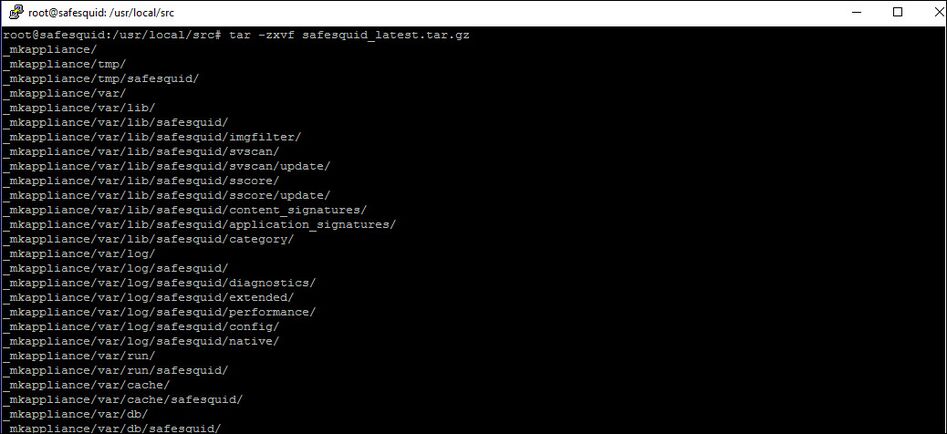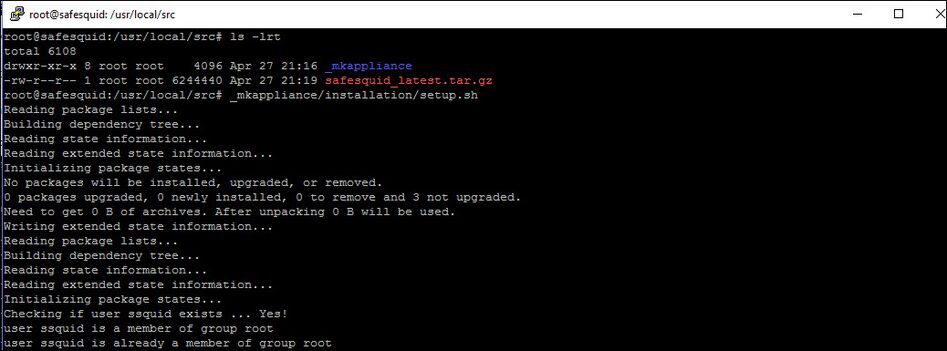Setup Your Secure Web Gateway on your preferred Linux distribution
Overview
SafeSquid Appliance Builder (SAB) is an optimized version of Ubuntu Linux, optimized for easy setup of your secure web gateway. The SAB installs the Ubuntu Linux operating system, downloads and deploys the SafeSquid for Linux installation package, and the necessary dependencies. SafeSquid can also be installed on any other Linux operating system like Red-Hat, SuSe, CentOS, etc.
Choose this method of installation only if you want to setup SafeSquid on already existing infrastructure or if you want to use other Operating System in Linux family other than Ubuntu. It requires some additional configurations like Monit and bind services used by SafeSquid.
Prerequisites
You must install required dependencies and other supporting services required for some modules of SafeSquid to work smoothly.
You can check and install required dependencies below.
Monit and Bind are other supporting services required by SafeSquid to work smoothly
Check - Configure Monit for SafeSquid Monitoring
Check - Bind Configuration with SafeSquid
Download latest version in Linux server
Go to the linux server and change the directory to “/usr/local/src” by using below command
cd /usr/local/src
Use "wget" command to download the latest SafeSquid package on the Linux machine on which you want to install the Safesquid. The command will download the tarball file.
wget http://downloads.safesquid.net/appliance/binary/safesquid_latest.tar.gz

Extract the tarball
Extract the files from tar by using below command.
tar -zxvf safesquid_latest.tar.gz
The output of the above command is shown below.

All the files will be extracted in the directory having name "_mkappliance".
You have to execute/run the setup.sh script to install SafeSquid.
_mkappliance/installation/setup.sh
Output after script execution is shown below.

Installation completes if you did not get any error.
Dependency Check
You can check if any of the dependencies missing for SafeSquid by using the "ldd" command as shown below.
ldd /opt/safesquid/bin/safesquid
Output for the above command is shown below.
linux-vdso.so.1 => (0x00007ffebebdb000)
libldap_r-2.4.so.2 => /usr/lib/x86_64-linux-gnu/libldap_r-2.4.so.2 (0x00007ff03107e000)
libpam.so.0 => /lib/x86_64-linux-gnu/libpam.so.0 (0x00007ff030e70000)
liblber-2.4.so.2 => /usr/lib/x86_64-linux-gnu/liblber-2.4.so.2 (0x00007ff030c61000)
libgssapi.so.3 => /usr/lib/x86_64-linux-gnu/libgssapi.so.3 (0x00007ff030a23000)
libdl.so.2 => /lib/x86_64-linux-gnu/libdl.so.2 (0x00007ff03081f000)
libresolv.so.2 => /lib/x86_64-linux-gnu/libresolv.so.2 (0x00007ff030604000)
libstdc++.so.6 => /usr/lib/x86_64-linux-gnu/libstdc++.so.6 (0x00007ff030300000)
libm.so.6 => /lib/x86_64-linux-gnu/libm.so.6 (0x00007ff02fffa000)
libgcc_s.so.1 => /lib/x86_64-linux-gnu/libgcc_s.so.1 (0x00007ff02fde4000)
libpthread.so.0 => /lib/x86_64-linux-gnu/libpthread.so.0 (0x00007ff02fbc6000)
libc.so.6 => /lib/x86_64-linux-gnu/libc.so.6 (0x00007ff02f7fd000)
libsasl2.so.2 => /usr/lib/x86_64-linux-gnu/libsasl2.so.2 (0x00007ff02f5e2000)
If any dependency is missing, then you might get error as shown below.
linux-vdso.so.1 => (0x00007ffebebdb000)
libldap_r-2.4.so.2 => /usr/lib/x86_64-linux-gnu/libldap_r-2.4.so.2 (0x00007ff03107e000)
libpam.so.0 => /lib/x86_64-linux-gnu/libpam.so.0 (0x00007ff030e70000)
liblber-2.4.so.2 => /usr/lib/x86_64-linux-gnu/liblber-2.4.so.2 (0x00007ff030c61000)
libgssapi.so.3 => /usr/lib/x86_64-linux-gnu/libgssapi.so.3 (0x00007ff030a23000)
libdl.so.2 => /lib/x86_64-linux-gnu/libdl.so.2 (0x00007ff03081f000)
libresolv.so.2 => /lib/x86_64-linux-gnu/libresolv.so.2 (0x00007ff030604000)
libstdc++.so.6 => /usr/lib/x86_64-linux-gnu/libstdc++.so.6 (0x00007ff030300000)
libgmp.so.3==> not found
libm.so.6 => /lib/x86_64-linux-gnu/libm.so.6 (0x00007ff02fffa000)
libgcc_s.so.1 => /lib/x86_64-linux-gnu/libgcc_s.so.1 (0x00007ff02fde4000)
libpthread.so.0 => /lib/x86_64-linux-gnu/libpthread.so.0 (0x00007ff02fbc6000)
libc.so.6 => /lib/x86_64-linux-gnu/libc.so.6 (0x00007ff02f7fd000)
libsasl2.so.2 => /usr/lib/x86_64-linux-gnu/libsasl2.so.2 (0x00007ff02f5e2000)
If you notice that any of the dependencies are not present then, you should install that dependenies to make SafeSquid work.
Start the SafeSquid
Further you need to Start the SafeSquid service by using below command
/etc/init.d/safesquid start
Testing
You can check whether SafeSquid service is running or not by using these commands.
pidof safesquid OR netstat -tulnp | grep "safesquid"

By default SafeSquid will listen on PORT 8080. If you observe SafeSquid is listening on any one of the ports shown in the image, then its confirm that SafeSquid has started.
See Also
1. Monit configuration for SafeSquid Monitoring
2. Bind configuration in SafeSquid Server
4. Integrate AD or OpenLDAP with SafeSquid